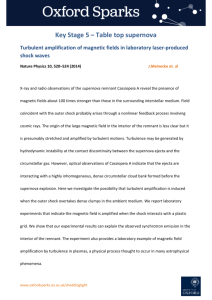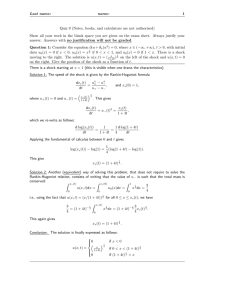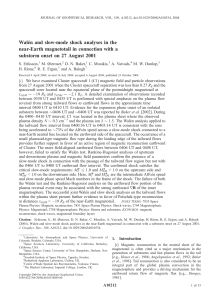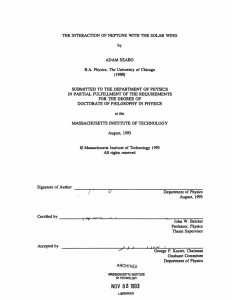III. PLASMA DYNAMICS D. T. Kyrazis
advertisement
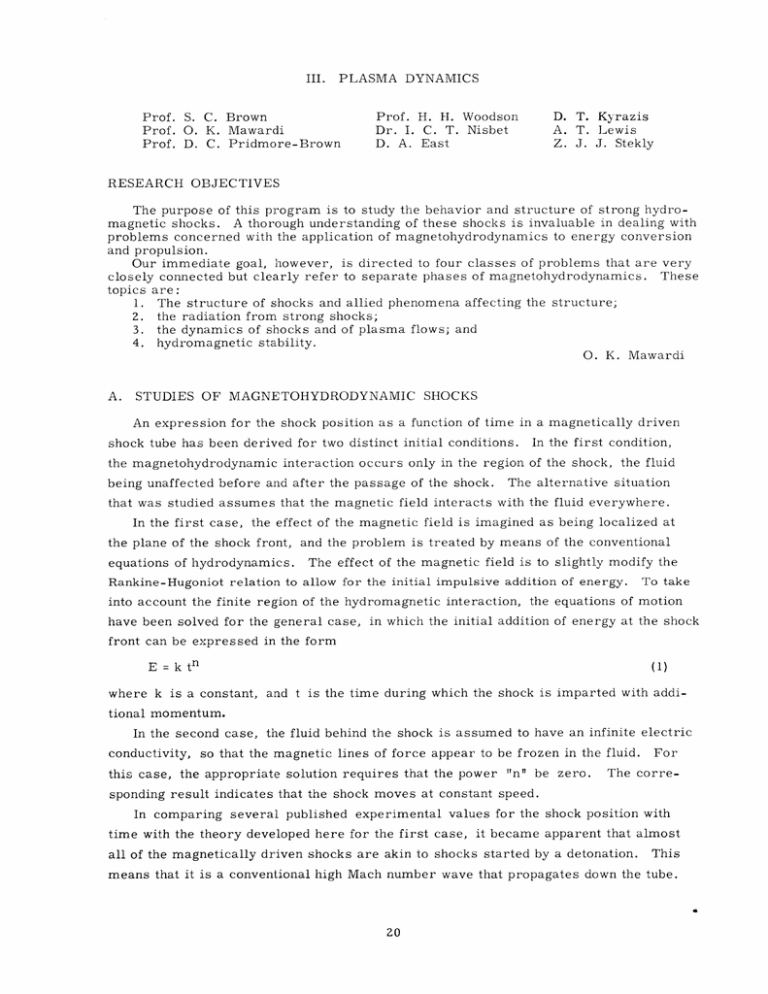
III. Prof. S. C. Brown Prof. O. K. Mawardi Prof. D. C. Pridmore-Brown PLASMA DYNAMICS D. T. Kyrazis A. T. Lewis Z. J. J. Stekly Prof. H. H. Woodson Dr. I. C. T. Nisbet D. A. East RESEARCH OBJECTIVES The purpose of this program is to study the behavior and structure of strong hydromagnetic shocks. A thorough understanding of these shocks is invaluable in dealing with problems concerned with the application of magnetohydrodynamics to energy conversion and propulsion. Our immediate goal, however, is directed to four classes of problems that are very These closely connected but clearly refer to separate phases of magnetohydrodynamics. topics are: 1. The structure of shocks and allied phenomena affecting the structure; 2. the radiation from strong shocks; 3. the dynamics of shocks and of plasma flows; and 4. hydromagnetic stability. O. K. Mawardi A. STUDIES OF MAGNETOHYDRODYNAMIC SHOCKS An expression for the shock position as a function of time in a magnetically driven shock tube has been derived for two distinct initial conditions. In the first condition, the magnetohydrodynamic interaction occurs only in the region of the shock, the fluid being unaffected before and after the passage of the shock. The alternative situation that was studied assumes that the magnetic field interacts with the fluid everywhere. In the first case, the effect of the magnetic field is imagined as being localized at the plane of the shock front, and the problem is treated by means of the conventional equations of hydrodynamics. The effect of the magnetic field is to slightly modify the Rankine-Hugoniot relation to allow for the initial impulsive addition of energy. To take into account the finite region of the hydromagnetic interaction, the equations of motion have been solved for the general case, in which the initial addition of energy at the shock front can be expressed in the form (1) E = k tn where k is a constant, and t is the time during which the shock is imparted with additional momentum. In the second case, the fluid behind the shock is assumed to have an infinite electric conductivity, so that the magnetic lines of force appear to be frozen in the fluid. this case, the appropriate solution requires that the power "n" be zero. For The corre- sponding result indicates that the shock moves at constant speed. In comparing several published experimental values for the shock position with time with the theory developed here for the first case, it became apparent that almost all of the magnetically driven shocks are akin to shocks started by a detonation. This means that it is a conventional high Mach number wave that propagates down the tube. (III. The second alternative does not lead to such a situation, throughout the whole travel of the wave. PLASMA DYNAMICS) the interaction taking place In the shock tube that is now in process of con- struction, provision has been made to have a constant magnetic field permeating the whole region of the tube so that the resulting wave will behave in accordance with the second case that was mentioned above. O. K. B. Mawardi, Z. J. J. Stekly CHANNELING AND COMPRESSION OF A PLASMA A series of experiments is being designed on the channeling and compression of a plasma that flows in a slowly converging "magnetic channel." Such channeling has been shown to be feasible under laboratory conditions by recent work at Los Alamos Scientific Laboratory on shock waves, but the transient nature of these flows prevents detailed study of the hydromagnetic interaction. In the present experiments a modification of a "plasma gun'" devised by Meyerand (1) will be used to produce a steady flow of moderately high-density plasma. My theoretical investigations have been based on the hydromagnetic equations for a compressible fluid with high scalar conductivity, a model believed to be a good approximation to the experimental conditions. The flow within the channel differs little from that obtained in the limit of infinite conductivity, obtained. and a complete solution has been The effects of the finite conductivity are restricted to the thin "mixing layer" between the plasma and the confining field, and an approximate solution for the flow in this layer has been derived from the hydromagnetic equations with the approximation of constant conductivity. These results suggest that the degree of compression attained in the magnetic channel may be limited by the finite conductivity, the mixing layer varies with the pressure. since the flow across Work in progress is based on models that include the variation of the conductivity with temperature and the finite Larmor radius. I. C. T. Nisbet References 1. R. G. Meyerand, Jr., The interaction of a plasma beam with a magnetic field, Quarterly Progress Report No. 51, Research Laboratory of Electronics, M.I.T., Oct. 15, 1958, p. 12.




